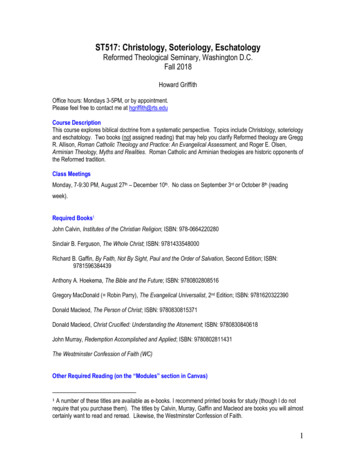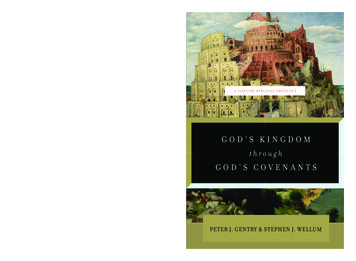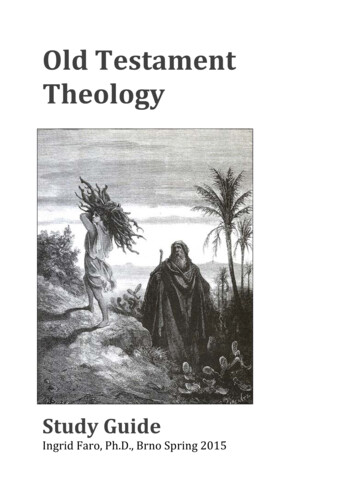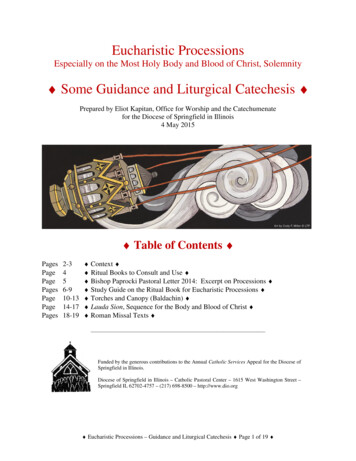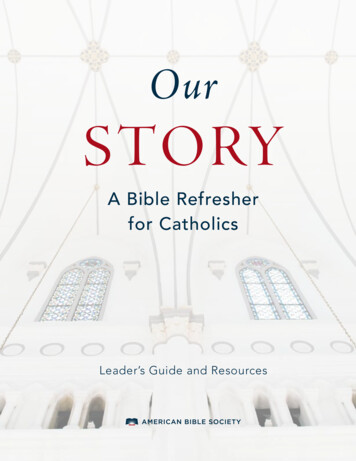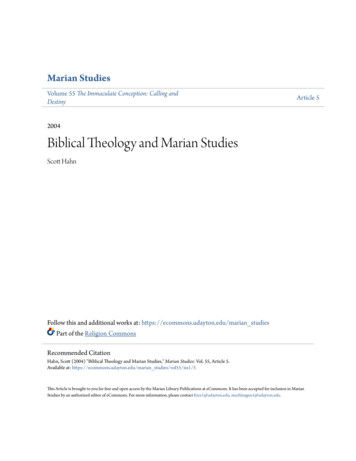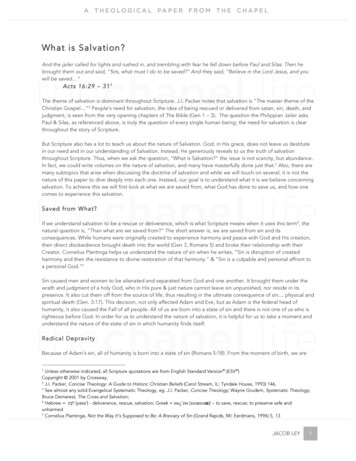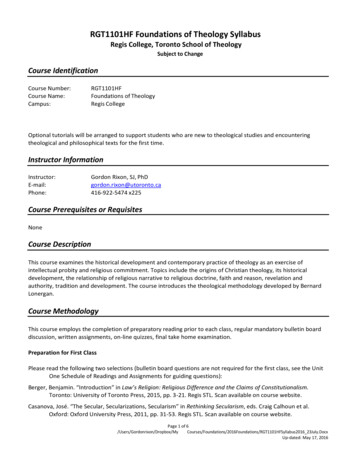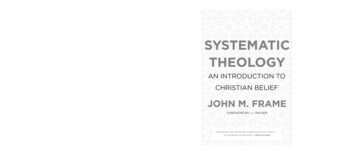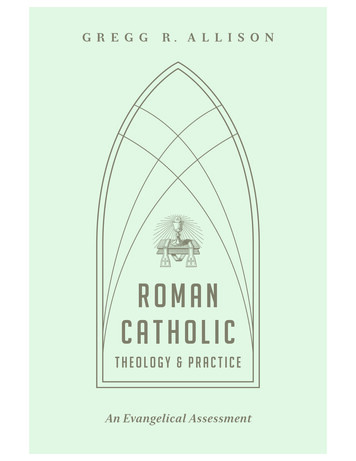
Transcription
G R E G GR. A L L I S O NRomanCatholicTHEOLOGY & PRACTICEAn Evangelical Assessment
“If you are looking for a few bullet points and caricatures, this book will disappoint.But if you are looking for a serious survey drawn from the Catholic Catechism and otherprimary sources, along with an evangelical assessment of each point, Professor Allison’slabors will pay rich dividends.”Michael Horton, J. Gresham Machen Professor of Systematic Theologyand Apologetics, Westminster Seminary California; author, Calvin onthe Christian Life“This book is good news to those who have long desired a reliable theological guide indealing with Roman Catholicism. Based on a painstaking analysis of the 1992 Catechismof the Catholic Church, it covers the all-embracing trajectory of Roman Catholic theology and practice. Instead of juxtaposing ephemeral impressions and disconnected data,Allison provides a theological framework that accounts for the complexity of the RomanCatholic system and its dynamic unity. This book is to be commended for its biblicaldepth, theological acuteness, historical alertness, and systemic awareness. My hope isthat this landmark book will reorient evangelical theology away from its attraction for ashallow ecumenicity with Rome toward a serious dialogue based on the Word of God.”Leonardo De Chirico, Lecturer of Historical Theology, Istituto di FormazioneEvangelica e Documentazione, Padova (Italy); pastor, Breccia di Roma, Rome;author, Evangelical Theological Perspectives on Post-Vatican II Roman andA Christian Pocket Guide to the Papacy“Writing with an irenic and thoughtful tone, Allison engages with Rome via the Church’sofficial Catechism and helps the reader understand what Protestants and Roman Catholics share in common and where they differ. This book is neither spinelessly ecumenicalnor harshly polemical, but a fair and principled engagement with the beliefs of Rome.”Carl R. Trueman, Professor of Church History, Westminster TheologicalSeminary; author, The Creedal Imperative and Luther on the Christian Life“A very useful evangelical assessment of Roman Catholicism. Unlike so many suchbooks, it does not concentrate merely on points of difference, but considers the wholesweep of Roman Catholic teaching, as set out in the Catechism of the Catholic Church.It affirms points of agreement as well as noting points of disagreement. It acknowledgesthat evangelicalism is not monochromatic and points to areas where some evangelicalswould agree with Rome while others would not. This is a thorough guide that is warmlyto be commended.”Anthony N. S. Lane, Professor of Historical Theology, London School ofTheology; author, Exploring Christian Doctrine
“With his characteristic depth and clarity, Gregg Allison escorts readers to the Catholic/Protestant intersection to analyze theological commonalities and differences. In additionto yielding indispensable insight, this volume exemplifies the sort of warmhearted andprincipled approach that today’s conversation desperately needs.”Chris Castaldo, Director, Ministry of Gospel Renewal, Wheaton College;author, Talking with Catholics about the Gospel“Protestants and Catholics need to invent a new kind of relationship. The fire and swordof the Reformation era were unworthy of Christ; so were the desperate efforts of irresponsible leaders in the past century to deny that we ever really disagreed. Can we preachdifferent views of the gospel and still love each other? If so, how do we understandthat relationship, spiritually and ecclesially? With a systematic thoroughness worthyof Thomas Aquinas himself, Gregg Allison lays out the theological issues at stake. Heprovides a full overview of the questions that face us, and his commitment to fully lovehis Catholic neighbors while fully speaking the truth to them shows us how to handleour disagreements in a manner worthy of Christ. This book will reward the carefulstudy it invites.”Greg Forster, Program Director, Kern Family Foundation; author,Joy for the World
Roman Catholic !eology and Practice
RomanCa t hol icT he ol og y and P r ac t ic eAn Evangelical AssessmentGREGG R. ALLISONW H E AT O N , I L L I N O I S
Roman Catholic Theology and Practice: An Evangelical AssessmentCopyright 2014 by Gregg R. AllisonPublished by Crossway1300 Crescent StreetWheaton, Illinois 60187All rights reserved. No part of this publication may be reproduced, stored in a retrieval system,or transmitted in any form by any means, electronic, mechanical, photocopy, recording, orotherwise, without the prior permission of the publisher, except as provided for by USAcopyright law.Cover design: Dual Identity, inc.First printing 2014Printed in the United States of AmericaExcept for Scripture included within quotations from the Catechism of the Catholic Church,Scripture quotations are from the ESV Bible (The Holy Bible, English Standard Version ),copyright 2001 by Crossway. 2011 Text Edition. Used by permission. All rights reserved.Scripture included within quotations from the Catechism of the Catholic Church are fromeither the Revised Standard Version or the New Revised Standard Version of the Bible; the textof the Catechism does not differentiate between the two versions, and therefore they are notdifferentiated in this present volume.Trade paperback ISBN: 978-1-4335-0116-6ePub ISBN: 978-1-4335-4541-2PDF ISBN: 978-1-4335-4539-9Mobipocket ISBN: 978-1-4335-4540-5Library of Congress Cataloging-in-Publication DataAllison, Gregg R.Roman Catholic theology and practice : an evangelicalassessment / Gregg R. Allison.pages cmIncludes bibliographical references and index.ISBN 978-1-4335-0116-6 (tp)1. Catholic Church—Doctrines. 2. Catholic Church—Customs and practices. 3. Evangelicalism. 4. CatholicChurch—Relations—Evangelicalism. 5. Evangelicalism—Relations—Catholic Church. I. Title.BX1753.A3952014282—dc232013047243Crossway is a publishing ministry of Good News Publishers.SH1514241323122211211020 19 189 8 7 617516 15 144 3 2 1
Roman Catholic Theology and Practice is dedicated to severalmen who have exerted a deep and abiding influence on my life:Roy Allison, who was God’s great gift to be my dear father, whounconditionally loved, counseled, guided, and provided for me; SteveKovic, who discipled me during my university years and sacrificedhis own dream for the sake of my further development; WayneGrudem, whom God used to form me into a theologian who isunreservedly committed to the truthfulness and clarity of Scripture;Gerry Breshears, who shepherded me as my teaching career wasbeginning and knew just how to encourage and challenge me; JohnFeinberg, whose teaching, mentoring, and supervising have made mea better scholar and writer; and Bruce Ware, whose friendship andappropriately timed phone calls were God’s instruments to direct meto the two faculty positions in which I have served. I love you menand am thankful to God for placing you in my life!
ContentsPreface: Intrigue and , Evangelical Theology, and Catholic TheologyScripture and Its InterpretationAn Evangelical Vision of Life with God and HumanFlourishingCatholic Theology as a Coherent, All-Encompassing SystemThe Nature-Grace InterdependenceEvangelical AssessmentThe Christ-Church InterconnectionEvangelical AssessmentConclusion31ICatholic !eology according to theCatechism of the Catholic ChurchPart 1: The Profession of Faith3The Profession of Faith (Part 1, Section 1, Chapters 1–3)The Human Capacity for God; the Doctrine of Revelation; theDoctrine of FaithIntroduction: The Nature and Shape of the CatechismThe Human Capacity for God (Sec. 1, Ch. 1)Evangelical Assessment71
The Doctrine of Revelation: God Comes to Meet HumanBeings (Sec. 1, Ch. 2)The Revelation of God (Art. 1)The Transmission of Divine Revelation (Art. 2)Sacred Scripture (Art. 3)Evangelical AssessmentDivine RevelationThe Transmission of Divine Revelation/Sola ScripturaScripture and Its InterpretationThe Canon of ScriptureThe Authoritative Interpretation of ScriptureThe Doctrine of Faith: The Human Response to God (Sec. 1, Ch. 3)Evangelical Assessment4The Profession of Faith (Part 1, Section 2, Chapter 1, Article 1—Chapter 3, Article 8)The Doctrines of God, Angels, Humanity, and Sin; the Doctrinesof the Person of Christ, the Incarnation, and the ImmaculateConception of Mary; the Work of Christ; Christ’s Resurrection,Ascension, and Second Coming; the Doctrine of the Holy SpiritThe Doctrines of God, Angels, Humanity, and Sin: “I believein God the Father almighty, creator of heaven and earth”(Sec. 2, Ch. 1, Art. 1)Evangelical AssessmentThe Doctrine of the Person of Jesus Christ: “. . . and in JesusChrist, his only Son, our Lord” (Sec. 2, Ch. 2, Art. 2)Evangelical AssessmentThe Doctrine of the Incarnation and the Doctrine of theImmaculate Conception: “he was conceived by the power ofthe Holy Spirit, and was born of the Virgin Mary” (Sec. 2,Ch. 2, Art. 3)Evangelical AssessmentThe Doctrine of the Work of Jesus Christ: “Jesus Christsuffered under Pontius Pilate, was crucified, died, and wasburied” (Sec. 2, Ch. 2, Art. 4)Evangelical AssessmentThe Doctrine of the Resurrection: “he descended into hell,on the third day he rose again” (Sec. 2, Ch. 2, Art. 5)117
Evangelical AssessmentThe Doctrine of the Ascension: “he ascended into heaven and isseated at the right hand of the Father” (Sec. 2, Ch. 2, Art. 6)Evangelical AssessmentThe Doctrine of the Second Coming and Divine Judgment:“from thence he will come again to judge the living and thedead” (Sec. 2, Ch. 2, Art. 7)Evangelical AssessmentThe Doctrine of the Holy Spirit: “I believe in the Holy Spirit”(Sec. 2, Ch. 3, Art. 8)Evangelical Assessment5The Profession of Faith (Part 1, Section 2, Chapter 3, Article 9)The Doctrine of the ChurchThe Doctrine of the Church: “I believe in the holy catholicchurch” (Sec. 2, Ch. 3, Art. 9; Para. 1–3)Evangelical AssessmentGeneral cityThe Doctrine of the Church: “I believe in the holy catholicchurch” (Sec. 2, Ch. 3, Art. 9; Para. 4–6)Evangelical AssessmentCatholic Clergy/HierarchyCatholic LaityCatholic ReligiousThe Communion of SaintsMary as Mother of the Church1596The Profession of Faith (Part 1, Section 2, Chapter 3, Articles 10–12)The Doctrines of Salvation, Our Future Resurrection, andEternal LifeThe Doctrine of Salvation: “I believe in the forgiveness ofsins” (Sec. 2, Ch. 3, Art. 10)Evangelical Assessment207
The Doctrine of Our Future Resurrection: “I believe in theresurrection of the body” (Sec. 2, Ch. 3, Art. 11)Evangelical AssessmentThe Doctrine of Eternal Life: “I believe in life everlasting”(Sec. 2, Ch. 3, Art. 12)Evangelical AssessmentConclusionIICatholic !eology according to theCatechism of the Catholic ChurchPart 2: The Celebration of the Christian Mystery7The Celebration of the Christian Mystery (Part 2, Section 1)The Liturgy and the Sacramental EconomyIntroduction: Why the Liturgy?Evangelical AssessmentThe Sacramental Economy (Sec. 1)The Liturgy—Work of the Holy Trinity (Sec. 1, Ch. 1, Art. 1)Evangelical AssessmentThe Paschal Mystery in the Church’s Sacraments (Sec. 1, Ch.1, Art. 2)Evangelical AssessmentThe Sacramental Celebration of the Paschal Mystery (Sec. 1,Ch. 2)Celebrating the Church’s Liturgy (Sec. 1, Ch. 2, Art. 1), andLiturgical Diversity and the Unity of the Mystery (Sec. 1, Ch.2, Art. 2)Evangelical Assessment2278The Celebration of the Christian Mystery (Part 2, Section 2,Chapter 1, Articles 1–2)The Seven Sacraments; The Sacraments of Christian Initiation:Baptism and ConfirmationThe Seven Sacraments of the Church (Sec. 2)The Sacraments of Christian Initiation (Sec. 2, Ch. 1)The Sacrament of Baptism (Sec. 2, Ch. 1, Art. 1)259
Evangelical AssessmentIntroductory MattersBiblical BasisHistorical DevelopmentFaith and BaptismExtraordinary ScenariosThe Sacrament of Confirmation (Sec. 2, Ch. 1, Art. 2)Evangelical Assessment9The Celebration of the Christian Mystery (Part 2, Section 2,Chapter 1, Article 3)The EucharistThe Sacrament of the Eucharist (Sec. 2, Ch. 1, Art. 3)Excursus: The Contemporary Celebration of the Sacramentof the EucharistEvangelical AssessmentSacramental Interpretation of the “Bread of Life”DiscoursePrefigurations of the EucharistThe Dogma of TransubstantiationRe-presentation of Christ’s SacrificeThe Church’s Participation in the Offering of ChristInfusion of GraceOngoing Worship of ChristRelationship of the Eucharist to Penance29910The Celebration of the Christian Mystery (Part 2, Section 2,Chapter 2, Articles 4–5)The Sacraments of Healing: Penance and Reconciliation;Anointing of the SickThe Sacraments of Healing (Sec. 2, Ch. 2)The Sacrament of Penance and Reconciliation (Sec. 2, Ch. 2,Art. 4)Evangelical AssessmentPenance Is Not a SacramentPre- and Post-Baptismal SinsTwo Moments of Conversion327
Acts of PenanceThe Two-Sided Nature of SinMortal and Venial SinsHuman and Divine ActionTwo Effects of PenanceIndulgencesThe Sacrament of the Anointing of the Sick (Sec. 2, Ch. 2,Art. 5)Evangelical AssessmentAnointing of the Sick Is Not a SacramentOther Disagreements11The Celebration of the Christian Mystery (Part 2, Section 2,Chapter 3, Articles 6–7)The Sacraments at the Service of Communion: Holy Orders;MatrimonyThe Sacraments at the Service of Communion (Sec. 2, Ch. 3)The Sacrament of Holy Orders (Sec. 2, Ch. 3, Art. 6)Evangelical AssessmentChurch Government/OfficesOld Covenant Levitical PriesthoodTwo Aspects of the PriesthoodMinisterial EffectivenessCelebration and Recipients of the SacramentThe Sacrament of Matrimony (Sec. 2, Ch. 3, Art. 7)Evangelical AssessmentConclusion357IIICatholic !eology according to theCatechism of the Catholic ChurchPart 3: Life in Christ12Life in Christ (Part 3, Section 1, Chapters 1–2)Human Vocation: Life in the Spirit; the Human CommunityHuman Vocation: Life in the Spirit (Sec. 1)391
The Dignity of the Human Person (Sec. 1, Ch. 1)Man: The Image of God (Sec. 1, Ch. 1, Art. 1)Our Vocation to Beatitude (Sec. 1, Ch. 1, Art. 2)Human Freedom (Sec. 1, Ch. 1, Art. 3)The Morality of Human Acts (Sec. 1, Ch. 1, Art. 4)The Morality of the Passions (Sec. 1, Ch. 1, Art. 5)Moral Conscience (Sec. 1, Ch. 1, Art. 6)The Virtues (Sec. 1, Ch. 1, Art. 7)Sin (Sec. 1, Ch. 1, Art. 8)Evangelical AssessmentThe Human Community (Sec. 1, Ch. 2)The Person and Society (Sec. 1, Ch. 2, Art. 1)Participation in Social Life (Sec. 1, Ch. 2, Art. 2)Social Justice (Sec. 1, Ch. 2, Art. 3)Evangelical Assessment13Life in Christ (Part 3, Section 1, Chapter 3)Salvation; Law; Grace and Justification; Merit; the Church,Mother and TeacherGod’s Salvation: Law and Grace (Sec. 1, Ch. 3)The Moral Law (Sec. 1, Ch. 3, Art. 1)Grace and Justification; Merit (Sec. 1, Ch. 3, Art. 2)The Church, Mother and Teacher (Sec. 1, Ch. 3, Art. 3)Evangelical AssessmentLawGrace and JustificationMeritThe Church, Mother and TeacherConclusion413Conclusion14Evangelical Ministry with Catholics453General Index459Scripture Index479
PrefaceIntrigue and CritiqueThe Catholic Church is everywhere one turns. In terms of its sheer size,the Church claims well over a billion adherents, so the Catholic faithful arepresent in most parts of the world. Wherever they are found, they are leaders in government, educational institutions, health care, social programs,law, business endeavors, the arts, and much more. The head of the Church,the pope, wields enormous influence on the international stage, not only interms of spiritual matters but also in the realms of politics, ethics, education, culture building, and the like. Recent scandals—child abuse by priests,the Vatican banking fiasco—have propelled the Church into the limelightwith widespread notoriety. Whether for good or for bad, the CatholicChurch is in the center of public attention.This Catholic Church finds itself celebrating the anniversaries of twomonumental events in its recent past: Vatican Council II, the twenty-firstgeneral council of the Church, was convened from 1962 to 1965. This aggiornamento, or updating, launched the Church on the path of modernization, the process of which continues as the Church celebrates the fiftiethanniversary of Vatican II. One of the most significant results of this journeyso far was the 1994 publication of the Catechism of the Catholic Church,a faithful and systematic presentation of the theology, liturgy, and practiceof the Church. (For American Catholics, this Catechism replaced the Baltimore Catechism of 1885.) In 2014 the Church marks and celebrates thetwentieth anniversary of the Catechism’s release.Given the widespread profile of the Catholic Church and the conjunction of these two anniversaries, together with my own long-term familiaritywith the Church, I offer this book. Roman Catholic Theology and Practice:An Evangelical Assessment seeks to accomplish two things: first, to notewith fascination and appreciation the commonalities between Catholic and
18 Preface: Intrigue and Critiqueevangelical theology—which I shall describe as the intrigue component; andsecond, to examine the differences between the two, demonstrating howCatholic theology and practice at these points of divergence do not conformproperly to Scripture—I’ll call it the critique component. Though I offerthis book primarily for evangelicals who want to become familiar with andassess Catholic theology and practice, I nourish a hope that some Catholicswill also read it to learn what evangelicals think about Catholic theologyand how they assess it. Roman Catholic Theology and Practice does not aimto be an anti-Catholic diatribe, though the critique that is offered is bothsustained and pointed. It does not pretend to be an assessment of all thingsCatholic; indeed, it is quite circumscribed in its scope, focusing on Catholicdoctrine and practice as unfolded in the Catechism of the Catholic Church.As such, it does not delve into how the Catholic faith is actually lived outby the faithful, nor does it engage the many faces of the Catholic Church interms of its national, ethnic, theological, and liturgical varieties. Moreover,I do not claim to speak for all evangelicals or to represent the many versionsof evangelical theology; given the expansive nature of evangelicalism, noone person and no one particular theological swath can accomplish thattask. As for evangelical responses to this book, I anticipate that some willresonate thoroughly with its assessment, some will complain that it is toointrigued with and appreciative of Catholic theology, and some will objectthat it has overly criticized Catholicism. In any case, I hope to stimulate myreaders’ reflection on and assessment of Catholic theology and practice byholding up the Catholic faith to Scripture and evangelical theology.All authors owe a debt of gratitude to many other people for their personal counsel, guidance, inspiration, suggestions, editorial help, corrections, and the like; Roman Catholic Theology and Practice is no exception.Specific contributions from Catholics came from Father James Keleher,my professor for “The Documents of Vatican II” course at St. Mary of theLake Seminary; Don Pio Iorg, with whom I worked in Lugano, Switzerland;Father Slider Steurnol, who contributed to my Catholic theology classesat Western Seminary; and various priests, monks, and deacons who havecontributed to my Catholic theology classes at Southern Seminary. Manythanks go to the original members of Alfa-Omega for giving Nora and mesuch an incredible opportunity to work with their nascent movement: DonCarlo Stanzial, Mario and Giulia, Ruggiero and Theresa, Lilli, Andrea,
Preface: Intrigue and Critique 19Luigi and Anna, Antonio, Margherita, Ninetta, Maria, Sandro and Velia,Sandro and Ornella, Annamaria, Stefano and Emilia, Roberto, la famigliaPoppi di Sorbara, and others who have faded from memory.Specific contributions from evangelicals came from Dr. Harold O. J.Brown, my professor for “Roman Catholic Theology” at Trinity Evangelical Divinity School; Drs. Kenneth Kantzer and John D. Woodbridge, whoshaped so much of my evangelical consciousness vis-à-vis other varietiesof Christendom; and Dr. John Nyquist (and Peggy), who was a model ofevangelical-Catholic dialogue.Cru staff members who particularly shaped Nora and me while we wereworking in a Catholic context were Dennis Becker, campus director of Cruat Notre Dame; Kalevi Lethinen, European director of Cru; his close associates Piryo Salminen and Markuu Happonen; Paul Cowen, national director of Cru in France; Jose Monels, national director of Cru in Spain; andGioele Baldari, Elfi Thaon de Revel, LeeAnn Weibel, and Donald Malcomb.More recently, sixteen Cru staff participated in my Institute of Biblical Studies elective course “Ministering to Catholics” in July 2013 and permittedme to use them as “guinea pigs” for the rough, rough draft of this book.Their discussion during class, and their insightful written comments onthe draft, prompted numerous changes and have made the final product amuch better book. Accordingly, I thank Mike Bost, Dawn Dishman, Jessicaand Nate Gilbert, Dan Hardaway, Linda Harrah, Bret and Elizabeth Hern,Andi Mitchell, Marci Scholten, James and Sarah Ward, David Westmoreland, Brian and Erin White, and my graduate assistant, Ben McGuire. Thestudents in my most recent “Contemporary Roman Catholic Theology”course at Southern Seminary also deserve thanks for their attentive readingand discussion of a draft of this book. A special thanks goes to our goodfriend Ann Casas for her suggested improvements.Colleagues and friends who have encouraged me in both ministry andthe writing of this book are Frank Beckwith, with whom I’ve had theprivilege of interacting in both print and oral presentation; Rob Plummer,editor of Journeys of Faith, who provided a written platform for Frankand me to exchange views; Chris Castaldo, author of Holy Ground: Following Jesus as a Former Catholic, who knows how to do just that ina winsome, direct way; and Leonardo De Chirico, whose PhD dissertation, published as Evangelical Theological Perspectives on Post-Vatican II
20 Preface: Intrigue and CritiqueRoman Catholicism, was crucial to my understanding Catholicism as atheological system.Most of all, many thanks go to my family for their support of my lifeand ministry: Lauren, Troy, Caleb, Ali, and Zoe Schneringer; Hanell, Mike,Anni, Hudson, and Vaughan Schuetz; Luke Allison; and my wife, Nora. Shesensed the same call of God, shared the dream of ministering to and withCatholics, labored so incredibly hard with me at Notre Dame and in Italy,left family and friends to move to a new country to learn a new languageso as to start and develop a new ministry, discipled scores of women, andalways encourages me to follow God’s leading, whether that has been serving on Cru staff, pursuing advanced degrees in theology, teaching at twodifferent seminaries, pastoring, writing books, or being her husband andthe father of our children.
AbbreviationsAllison, HTGregg R. Allison, Historical Theology: An Introduction toChristian Doctrine (Grand Rapids, MI: Zondervan, 2011).Allison, SSGregg R. Allison, Sojourners and Strangers: The Doctrine of theChurch (Wheaton, IL: Crossway, 2012).ANFAnte-Nicene Fathers, ed. Alexander Roberts, James Donaldson,Philip Schaff, and Henry Wace, 10 vols. (Peabody, MA: Hendrickson, 1994).Calvin, Institutes John Calvin, Institutes of the Christian Religion, ed. John T.McNeill, trans. Ford Lewis Battles (Philadelphia: Westminster,1960). (See also the listings below for LCC 20 and LCC 21; references for the Institutes are provided in those sources as well.)CCCCatechism of the Catholic Church (New York: Doubleday,1995).De ChiricoLeonardo De Chirico, Evangelical Theological Perspectives onPost-Vatican II Roman Catholicism. Religions and Discourse,vol. 19 (Bern: Peter Lang, 2003).Grudem, STWayne Grudem, Systematic Theology: An Introduction to Biblical Doctrine (Grand Rapids, MI: Zondervan, 1994, 2000).HeppeHeinrich Heppe, Reformed Dogmatics, ed. Ernst Bizer, trans.G. T. Thomson (London: Allen & Unwin, 1950).KreeftPeter Kreeft, Catholic Christianity (San Francisco: Ignatius,2001).LCC 20John Calvin, Institutes of the Christian Religion, ed. John T.McNeill, trans. Ford Lewis Battles (Philadelphia: Westminster, 1960), in John Baillie, John T. McNeill, and Henry P. VanDusen, gen. eds., Library of Christian Classics, 26 vols. (Philadelphia: Westminster, 1960), vol. 20.LCC 21John Calvin, Institutes of the Christian Religion, ed. John T.McNeill, trans. Ford Lewis Battles (Philadelphia: Westminster, 1960), in John Baillie, John T. McNeill, and Henry P. VanDusen, gen. eds., Library of Christian Classics, 26 vols. (Philadelphia: Westminster, 1960), vol. 21.LWMartin Luther, Luther’s Works, ed., Jaroslav Pelikan, Hilton C.Oswald, and Helmut T. Lehmann, 55 vols. (St. Louis: Concordia, 1955–1986).
22 AbbreviationsNPNF1Nicene and Post-Nicene Fathers, ed. Alexander Roberts, JamesDonaldson, Philip Schaff, and Henry Wace, 1st ser., 14 vols.(Peabody, MA: Hendrickson, 1994).NPNF2Nicene and Post-Nicene Fathers, ed. Alexander Roberts, JamesDonaldson, Philip Schaff, and Henry Wace, 2nd ser., 14 vols.(Peabody, MA: Hendrickson, 1994).SchaffPhilip Schaff, Creeds of Christendom, 3 vols. (New York:Harper, 1877–1905).SchmidHeinrich Schmid, The Doctrinal Theology of the EvangelicalLutheran Church, trans. Charles A. Hay and Henry E. Jacobs(Minneapolis: Augsburg, 1899).VC II-1Austin Flannery, gen. ed., Vatican Council II: Volume 1, TheConciliar and Post-Conciliar Documents, new rev. ed. (Northport, NY: Costello; and Dublin: Dominican, 1998).VC II-2Austin Flannery, gen. ed., Vatican Council II: Volume 2, MorePost-Conciliar Documents, new rev. ed. (Northport, NY:Costello; and Dublin: Dominican, 1998).
1IntroductionComically speaking, the genesis of this book occurred when I, as a fiveyear-old, was told by a similarly young (pre-Vatican Council II) Catholicneighbor girl that I was headed straight to hell because I wasn’t Catholic.Greatly upset and fearing for my eternal destiny, I asked my parents if wecould go to church, and they promptly responded by taking me to the localUnited Methodist church. Though that choice did nothing to change theneighbor girl’s assessment of and warning about my future condemnation,it at least started me down the Protestant pathway. After nurturing me onthe works of Martin Luther, Huldrych Zwingli, John Calvin, John Wesley,and many others, this road has brought me to the place where I am today:an evangelical systematic theologian of the Reformed Baptist variety.Seriously, however, the origin of this book began in May 1976, when myfiancée (now wife, Nora) and I were visiting a businessman in Chesterton,Indiana, near South Bend. We had received permission from Campus Crusade for Christ (now Cru) to begin raising support for our future campusministry with that parachurch organization. During our conversation, inwhich Nora and I presented our upcoming work, the businessman jokinglyexclaimed, “Wouldn’t it be interesting if the two of you were assigned to beCru staff at the University of Notre Dame.” After a hearty laugh—“Sure,a Protestant missionary movement on the campus of the premier Catholicuniversity in the United States!”—we concluded our presentation and saidour thanks and good-byes. Getting into our car to return home, Nora (fromthe passenger side) and I (from the driver’s side) looked at each other and,together, with a strong, divinely given conviction, said, “God is calling usto the University of Notre Dame.”After our wedding, honeymoon, and the commencement of our preparation as Cru staff, we received a Placement Request Form as part of our
24 Introductiontraining. One of the questions on this form had to do with where we hopedto be placed. We promptly wrote in our assignment preference: “the University of Notre Dame.” Soon after receiving our response, Cru leadersresponsible for staff placement called us in for a little chat. They were quiteintrigued that we wanted to go to Notre Dame (ND), as the Cru ministrywas just beginning on that campus, and they were looking to assign morestaff to join the small initial team. Nora and I, however, failed to meettheir three qualifications: we did not come from a Catholic background, wewere not veteran staff (who usually are responsible for starting new campusministries), and we did not have children (so as to be in a similar season oflife as the Cru staff couple already working at ND). Strike one. Strike two.Strike three. The Allisons were not going to be Cru staff at Notre Dame.A bit later, to the same question on the second Placement RequestForm, we wrote, “the University of Notre Dame.” Somewhat perturbed,our placement leaders called us in for another conversation, wonderingwhat about the initial “No, you are not going to be assigned to NotreDame” we didn’t understand. They tried to comfort us with the possibility that we would end up at Notre Dame after we had been on Cru stafffor a number of years, but they assured us ND was not in our immediatefuture. Of course, we assured them that we were willing to go anywherethey assigned us. But deep down inside lingered the firm conviction thatGod was calling us to Notre Dame.Accordingly, when the third Placement Request Form was distributed aweek or so later, our reply to the now infamous question was “the University of Notre Dame.” The placement leaders’ flustered and emphatic response to what seemed like an intractable stance on our part was, “PerhapsGod is calling you to Villanova or some other Catholic university, but youare not going to the University of Notre Dame!”Another strike three for the second out.Shortly thereafter, and along with all the new Cru staff, Nora and I received our Placement Envelope. Written on the form inside was our futureassignment. Bound by a promise that we would not discuss the enclosedcontent with anyone else for a period of silence (twenty-four hours, whichwas to be used sol
dealing with Roman Catholicism. Based on a painstaking analysis of the 1992 Catechism of the Catholic Church, it covers the all-embracing trajectory of Roman Catholic theol-ogy and practice. Instead of juxtaposing ephemeral impressions and disconnected data, Allison provides a theological framework that
